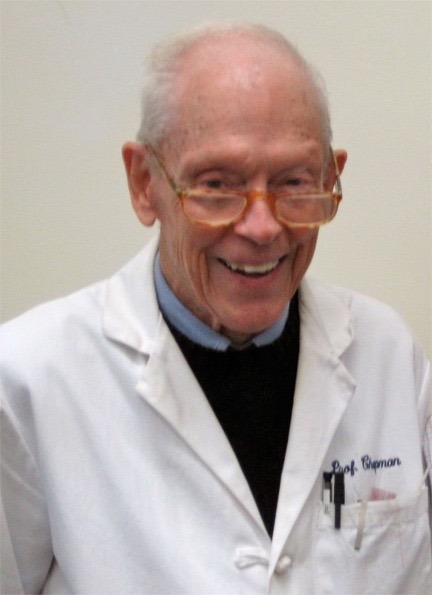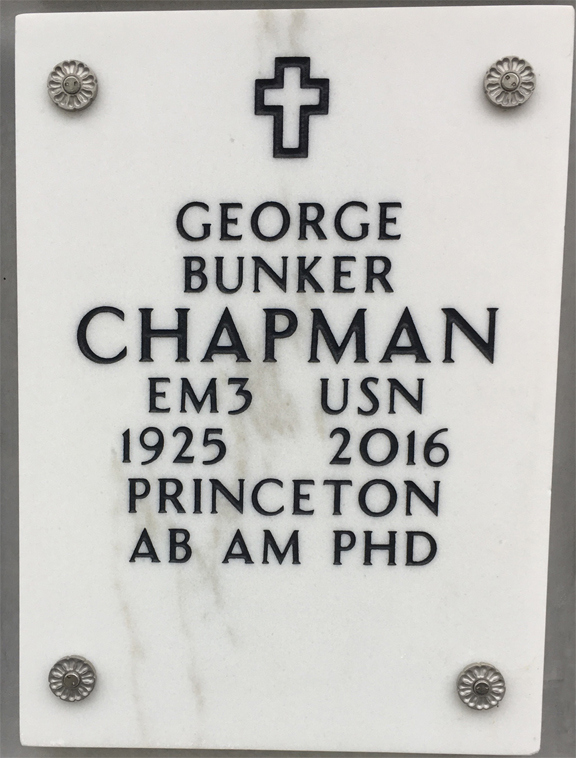 In 1974, when I left the USAF, I applied to a number of graduate schools, among them Georgetown University. My intention at that time was to obtain a Master's degree in Biology (my undergraduate major) and become a high school teacher. As things worked out, my application to GU brought me into contact with one of the best men I ever knew, and changed the direction of my life forever: the Department Head, Dr George B. Chapman. George was then in his late 40’s. He’d come to GU to shake up a moribund department in 1963. He established the graduate degree program, among other innovations, and was at the time of my enrollment at the peak of his powers.
In 1974, when I left the USAF, I applied to a number of graduate schools, among them Georgetown University. My intention at that time was to obtain a Master's degree in Biology (my undergraduate major) and become a high school teacher. As things worked out, my application to GU brought me into contact with one of the best men I ever knew, and changed the direction of my life forever: the Department Head, Dr George B. Chapman. George was then in his late 40’s. He’d come to GU to shake up a moribund department in 1963. He established the graduate degree program, among other innovations, and was at the time of my enrollment at the peak of his powers. I was—to be charitable to myself—a less-than-distinguished undergraduate student. But the military and wartime service teaches you more than any college can; by the time I'd finished 4 years on active duty I'd settled down and was willing to take on a new challenge. George had been a radioman in the Navy during WW 2 and seems to have had a soft spot for veterans as a result. Thanks to his being willing to give me a chance Georgetown accepted me: the other schools had, at best, offered me only conditional admission. I enrolled in the Fall of 1974, still not entirely sure whether I was ready to dive back into an academic environment.
George was a pioneer in a relatively new field. He was one of the very first biological electron microscopists. He was a graduate student under James Hillier, the man who in 1938 had built the very first practical EM's; Hillier was (and is) something of a legend in the structural biology community and really should have had a Nobel Prize, but as in many other cases, things didn't work that way. After completing his undergraduate and graduate degrees at Princeton University, George became Hillier’s graduate student, in fact the only one Hillier ever taught. As a graduate student and afterwards, George pioneered several methods in biological EM work that are now standard procedure: what was cutting edge science in 1953 is today routinely taught to undergraduates, but he was the first to develop them and report them in scientific journals. Nicolas Rasmussen’s history of the discipline, Picture Control: The Electron Microscope and the Transformation of Biology, 1940-1960 cites George as one of the first generation of biologists whose work created the foundation of modern concepts of biological science. In developing his techniques, George worked with a couple of Nobel winners, among them George Palade, who first described the structure of the mitochondrion. George Chapman’s pathbreaking work established his professional name to the degree that he was offered a chairmanship very early in his career.
One of the first courses I took at Georgetown was his signature, offering, “Cytology and Histology” After that I was completely committed to working with him: the next year I became his teaching assistant for that course and later for his course in biological EM. I worked as his assistant for the next 4 years, and considered it a privilege to have done so. George was an excellent role model for someone who had plans someday to become a faculty member: he was a dryly humorous, if somewhat pedantic lecturer, a perfectionist in lab work, and a true mentor to someone who badly needed one.
He lived with his aging mother all her life, and never married, despite what I know to have been true: he was immensely attractive to women. One truly spectacular redhead in his class told me once that she would have "..thrown myself at his feet.." if she could have. Perhaps Mother would have had a great deal to say about any woman George was interested in other than her. In any event, after her death in her 90's, he lived alone.
In truth, he was married to his work. He spent more than 50 years in Georgetown's Biology Department, finally retiring—after being more or less shoved out unwillingly—in 2011, well into in his late 80's. His working day was devoted to teaching, advising graduate students, and publishing journal articles. In many ways he was the ultimate occupant of the Ivory Tower, the very model of a "gentleman and a scholar." To see him in his academic regalia at University events was to realize that the myth of the Pure Academician was not, in fact, entirely a myth.
I asked George early on to be my Major Professor, because I wouldn't have had anyone else. He agreed, and moreover encouraged me immensely; after my first year, he suggested I bypass the Master's degree entirely and go straight for the doctorate. I did, and in 1980 received my "hood" at his hands, a very proud moment for both of us.
In the 36 years since I graduated and almost until his death we kept up a regular correspondence. Every year we would exchange Christmas letters, and I learned about his work, as well as his frustrations as younger faculty moved up in the ranks and the university administration decided he was "surplus to need," leaning on him to retire. He expressed more than once his regrets that he'd not taken advantage of opportunities to travel until it was too late for him to do so, and he kept advising me to make the most of my relative youth, warning me not to do what he'd done (or not done). The last time I saw him in person was in 1999 or 2000. He had an electron microscope, a first-generation RCA EMU-2D that he'd acquired in the 1950's. This old instrument he moved from one place to another over his career, lovingly maintaining it with his own hands. That old RCA was used by Palade in his Nobel-winning work, and also by Keith Porter, another of the first generation microscopists who should have received the Nobel and didn’t.
 He died on September 7th 2016, at age 91. Some of his old students were with him, and some of his former colleagues made his final arrangements and set up a memorial service at Arlington National Cemetery.
He died on September 7th 2016, at age 91. Some of his old students were with him, and some of his former colleagues made his final arrangements and set up a memorial service at Arlington National Cemetery.